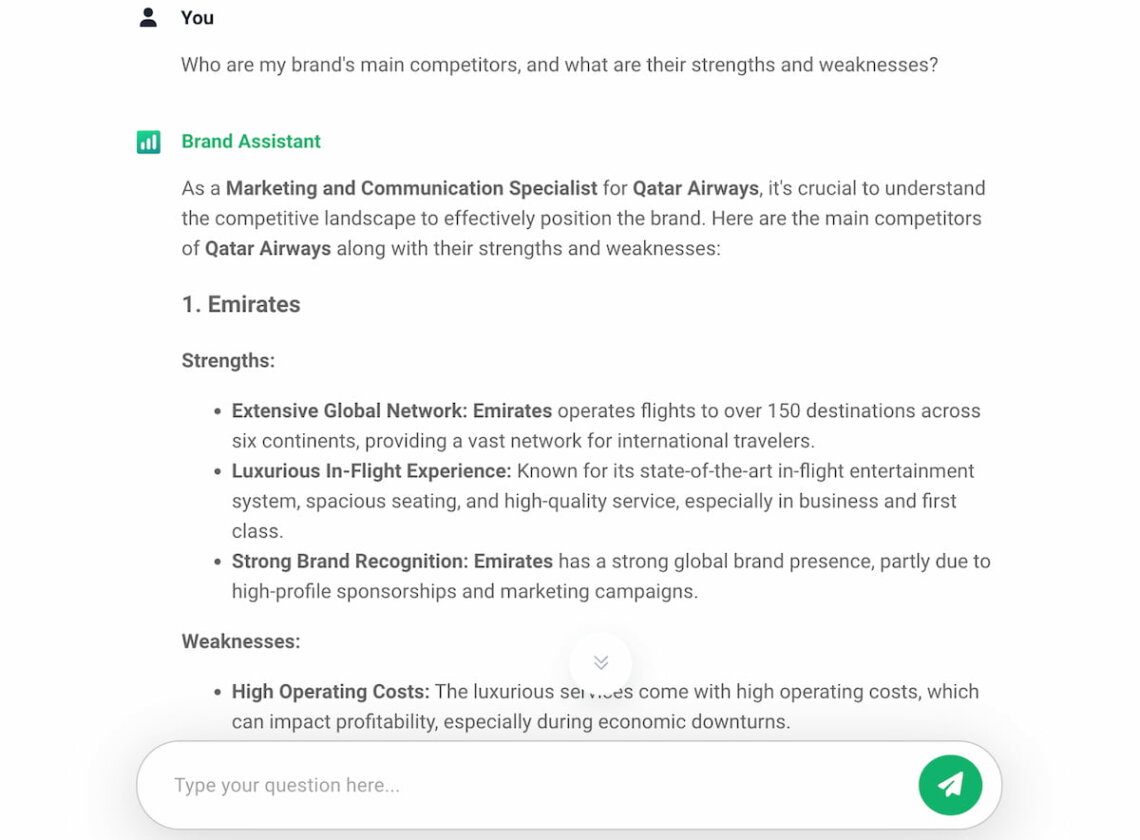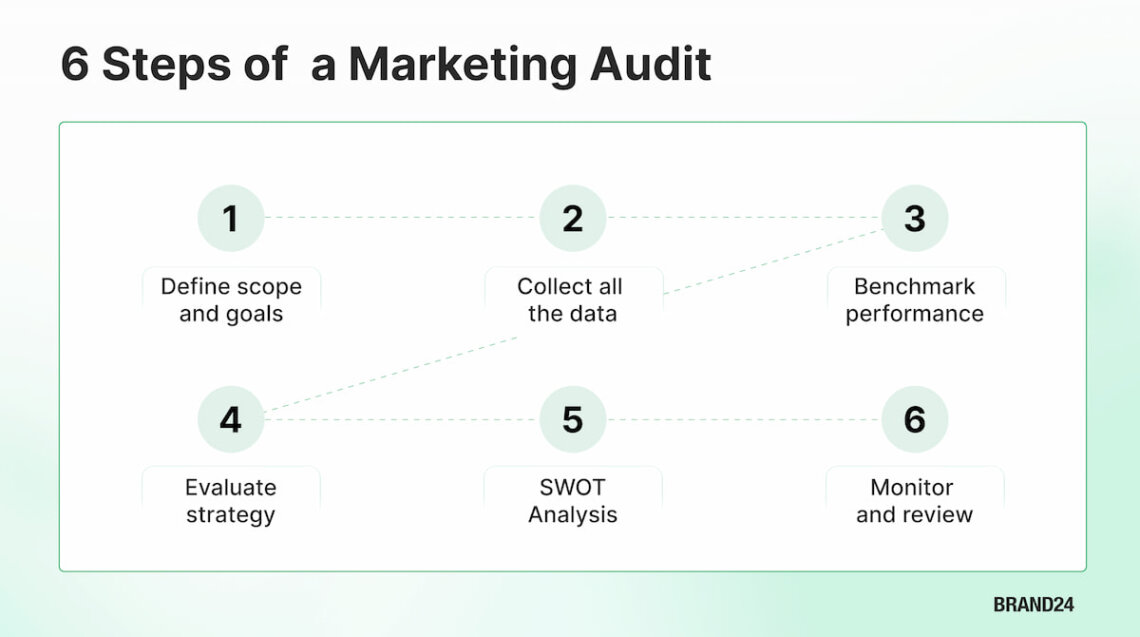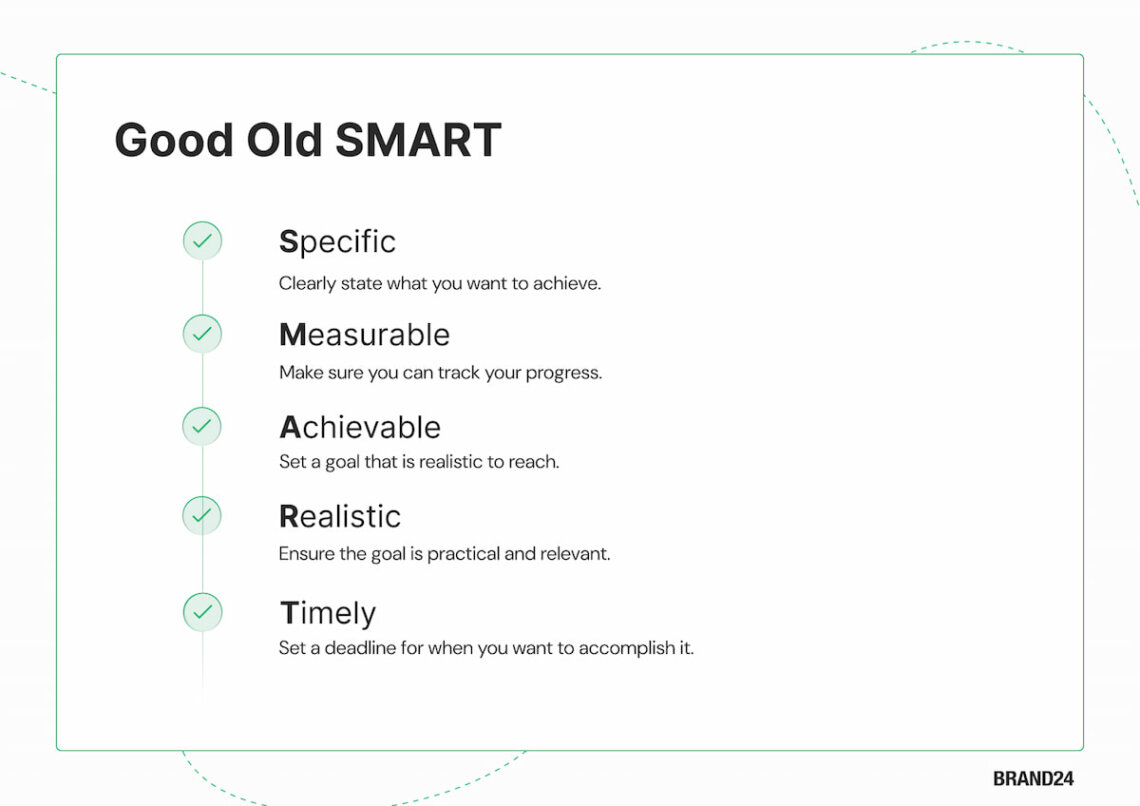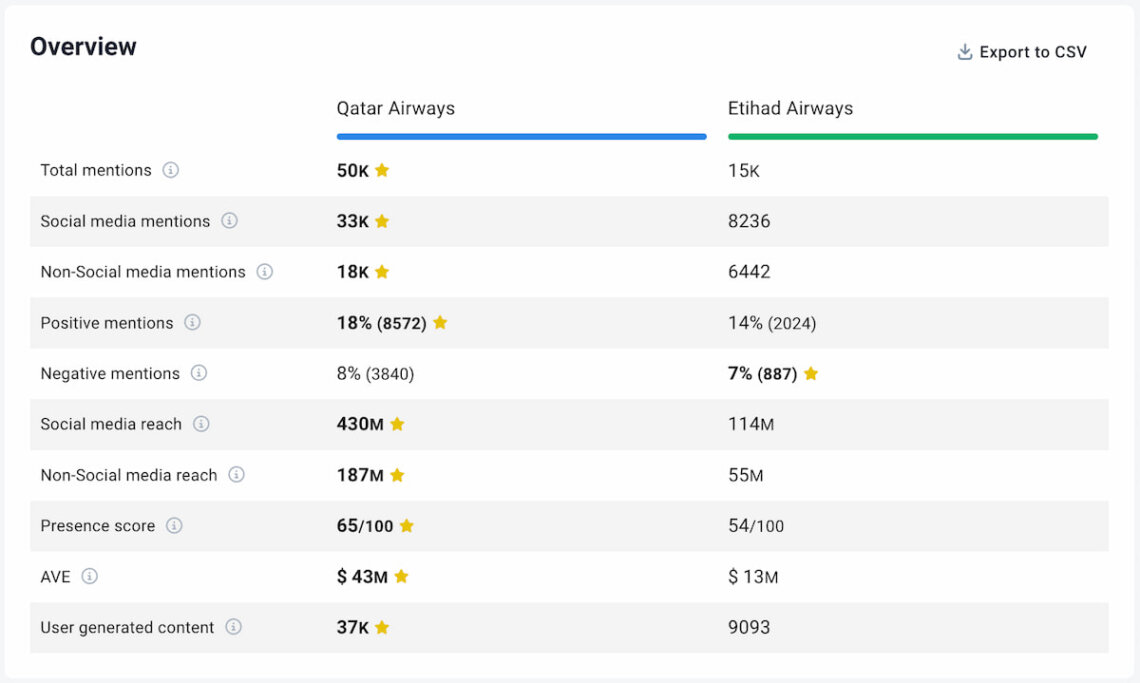How to Do a Marketing Audit? The 6 Step Guide [2025]
Table of contents
Doing marketing without regular audits is like driving a car without regular check-ups. You might be moving, but you have no idea when and what will break. And eventually, something WILL break. Costs of unexpected repairs are always higher than the money spent on regular maintenance – both for cars and marketing. Not to mention how much time you can waste! That’s why a marketing audit is essential to keep your efforts on track. Especially since it’s easier than you think!
A marketing audit is a comprehensive review and analysis of your current marketing strategies, activities, and performance. It’s all about identifying strengths, weaknesses, opportunities, and threats to help you improve your future marketing efforts.
The goal of a marketing audit is to ensure that all your marketing activities support your business objectives and effectively influence your target audience.
It’s Tuesday, and you walk into the office early morning.
The day is hot and humid, but the air conditioner is working hard, cooling the room just enough. The scent of fresh coffee fills the air, and everything seems like it’s going to be just another day at the office.
You sit down at your desk, open your computer, and check your chat. Only one notification – phew! A small victory.
You click on the message and suddenly feel a faster heartbeat.
“Hey, we have to do a marketing audit till Friday. Can you take care of it?”.
Your mind races. A marketing audit? By Friday? That’s only three days away!
You take a deep breath and type back: “Sure, I’m on it!”, but your fingers hang over the keyboard before clicking “Send”. Your pulse quickens and you’re feeling a mix of stress and excitement.
This is a challenge, no doubt, but it’s also an opportunity to prove yourself. You love testing yourself, and this is your chance to dive in and make a real impact.
Click. Let the fun begin!
What is a marketing audit?
First things first. What exactly a marketing audit is?
In short, it’s a process of optimizing your current marketing efforts to make them more efficient and profitable.
A comprehensive marketing audit examines your entire marketing strategy from top to bottom.
It involves a detailed analysis of:
- Every marketing channel you use (social media, SEO, ads, content, etc.);
- Brand performance;
- Market research;
- Pricing strategy;
- Competitive analysis.
Besides focusing on your current marketing tactics, the whole process may include an internal marketing audit that touches elements like your team structure, key performance indicators (KPIs), marketing budget allocation, and so on.
Remember, though, that conducting marketing audits is not only about highlighting what’s going wrong. They also show what you are doing right and how you can leverage your strengths to achieve even better results!
A successful marketing audit must be:
- Comprehensive, so consider all aspects of your marketing strategy (because they are interrelated), business goals, and customer needs;
- Objective, so driven by realistic data, unbiased facts, and measurable results rather than opinions or assumptions;
- Actionable, so providing clear and practical recommendations for improvements according to SMART criteria (specific, measurable, achievable, realistic, and timely).
Try the best marketing audit tool!
Why should you conduct a marketing audit?
After discovering what a marketing audit is, it’s time to answer the second essential question: why should you conduct a marketing audit process?
Simply put, an effective marketing audit:
- Helps you identify strengths and weaknesses in your strategy, allowing you to focus on what works and improve what doesn’t;
- Pays off because you can optimize the allocation of your budget, time, efforts, and human resources and maximize your ROI;
- Ensures your marketing efforts stay aligned with your overall business goals, driving consistent and meaningful results;
- Enables you to adapt to market trends, changing customer preferences, and your competitors’ moves;
- Uncovers new business growth opportunities, such as untapped markets or emerging trends, help you stay ahead of the competition.
Enjoy the benefits of a marketing audit!
Pro Tip: Ask AI tools for audit
At the beginning of this article, I promised that conducting a marketing audit is easier than you might think. And it truly is!
The game-changer is the possibility of using AI tools to help perform marketing audits faster than ever. And I don’t exactly mean all these widely recognizable solutions like ChatGPT.
Don’t get me wrong, they can do a great job for you. The problem is that they don’t access real-time data specific to your company or industry.
What you need are AI tools designed specifically for marketing audits. Tools that can tap into your actual performance metrics, competitor data, and market trends.
One of them is Brand24 and its AI-powered feature called Brand Assistant.
In general, Brand24 is a media monitoring software that allows you to track and analyze terabytes of data about your brand, competitors, and industry mentions.
As for the AI Brand Assistant, the idea is simple – it’s a chatbot with direct access to your internal data that can be asked about everything related to your brand.
And it generates very insightful responses!
The Brand Assistant can recognize & interpret patterns, identify areas for marketing improvements, spot trends, and share personalized recommendations.
With AI Brand Assistant, you can quickly get answers to complex questions, like:
- What are the key strengths of my brand’s current marketing strategy?
- Who are the top influencers promoting my brand, and how can I leverage their influence further?
- Who are my brand’s main competitors, and what are their strengths and weaknesses?
- What is my competitor’s unique value proposition?
- What are the primary concerns or negative feedback points from customers, and how can I address them to improve customer satisfaction?

Let AI do the job for you!
How to do a marketing audit?
It’s Wednesday morning.
You spent most of yesterday preparing for your marketing audit.
Now you know what it is, what’s the purpose of doing it, and how to make it fast.
You put your headphones on, play your favorite Spotify playlist, and dive into the task.

Step 1: Define scope and goals
Scope
First, you need to define how far-reaching your audit is gonna be. In other words, at the beginning of your audit, decide which areas of your marketing strategy you will evaluate.
Will you focus on specific channels like social media and email, or will you review the overall marketing strategy, from branding and messaging to customer engagement and conversion rates?
Clear boundaries build the box that keeps you moving in the designated area only.
Without them, you could start discussing customer persona updates and end up rethinking the entire product line, the meaning of life, or even developing a crisis procedure in the event of an alien invasion.
Moreover, a marketing audit consumes resources. There’s no need to involve people from outside the defined scope.
Goals
As for goals, it’s pretty straightforward: the ultimate purpose of marketing audits is to increase the likelihood of achieving marketing objectives.
All your key marketing objectives should be well-structured and clearly defined to guide the audit process. It’s like navigating a ship at night. Each of your goals is your North Star, pointing the direction to follow.
They should be based on the SMART criteria.

For example, if you’re thinking about how to do a content marketing audit, you might set a goal like “increase blog traffic by 20% over the next quarter by optimizing existing articles and creating new content that targets high-performing keywords”.
Try the best marketing audit tool!
Step 2: Collect data
Marketing audit without data is like a Jedi without the Force – powerless and without direction.
Data is what gives you the insights and clarity to make strategic decisions, guiding your next move and helping you stay one step ahead of the competition.
Without it, you’re just waving your lightsaber in the dark, hoping not to get hit by a blaster bolt (good luck, dude).
The most important data you need to do a marketing audit are:
- Conversion path
- Website traffic and analytics
- User journey
- Audience demographics
- Competitors performance details
- Top influencers
- Sentiment analysis
- Top sources of mentions
- Brand awareness
- Customer feedback and reviews
Get the most important marketing data fast!
Step 3: Evaluate marketing strategy
Now that you have your scope, goals, and data, it’s time to evaluate your marketing strategy. What works well? What isn’t? And how the heck to begin this marketing strategy evaluation?!
First, take a deep breath and relax.
Second, take another breath.
Third, smile, because the web is full of amazing tools that will help you in that!
From marketing analytics tools and platforms like Google Analytics and Google Search Console to social media insights from Meta Business Suite, you have access to a wealth of data at your fingertips.
They allow you to dive into key metrics, such as website traffic, social media campaigns details, conversion paths, and so on.
I strongly recommend that you read my colleague’s article about key digital marketing metrics to understand what exactly you should measure!
I have to add that there are a lot of marketing tools – like Brand24 – that enable you to make your audit even more comprehensive.
It’s time for a quick example. Let’s make a very basic audit of Qatar Airways.
Brand24 offers two very handy metrics to check your brand performance fast:
- Presence Score summarizes your brand’s online exposure and popularity at a given period.
- Reputation Score shows how favorably or unfavorably people talk about your brand.
As you see below, Qatar Airways’ Presence Score in the second quarter of 2024 was generally high and constant.
Regarding Reputation Score, the airline had started on a low level but it significantly improved over time.
That’s good!

The tool also allows you to check and analyze your top influencers…

… top sources, trends, topics, your brand popularity by country, and so much more!
Better try Brand24 by yourself!
Step 4: Benchmark performance
Now, after evaluating your marketing strategies, it’s time to measure your marketing performance against industry standards, competitors, and your own past results.
You simply need a reference point to determine whether your marketing campaigns and efforts are performing well and which areas need improvement.
Again, I’ll show you how to do it like a pro. First, let’s start our digital marketing audit by checking the company’s historic performance.
I used Brand24’s “Compare periods” feature to benchmark the first and second quarters of 2024.
Obviously, Qatar Airways’ online performance and reputation improved. To discover what drove that, I asked the AI Brand Assistant.

According to it, the top drivers of Qatar Airways success in Q2 compared to Q1 were:
- A higher engagement in sponsorships of sports events (Qatar Airways Cup, Australian Motorcycle Grand Prix) and teams (Paris Saint-Germain, The Brooklyn Nets),
- Winning a prize of the World’s Best Airline,
- Introducing the AI Digital Human Cabin Crew.
Of course, I don’t have access to Qatar Airways’ marketing objectives document, but I suppose these achievements align with their goals to increase brand visibility and strengthen their market share.
Wow, you’re doing great this month! Check how!
As stated before, benchmarking is also about competitor analysis. So, let’s do it quickly!
I compared Qatar Airways with another Middle Eastern airline, Etihad Airways, in the second quarter of 2024.
As you see, the Qatari company leads in nearly all categories except the share of negative brand mentions.

Again, I asked the Brand Assistant to explain it in detail.
It turned out that Qatar Airways experienced more incidents (like turbulence, denied boarding, or air conditioning failure) that drove negative attention than their rivals.
What could be a possible conclusion in their detailed marketing audit?
For example, they could improve their customer communication strategy to handle negative incidents better and provide quicker responses on social media.
Override your competitors with Brand24!
Step 5: Conduct a SWOT analysis
A SWOT analysis is like the icing on the cake.
It’s one of the most popular and effective techniques for evaluating your marketing strategy.
This method breaks down your strategy into four key areas:
- Strengths underline what you do better than your competitors and what to keep to leverage for continued success;
- Weaknesses identify areas where you’re doing worse and need improvements to minimize their negative results;
- Opportunities spot emerging trends, markets, or segments that can be used to grow;
- Threats recognize external challenges that could impact your business, such as dynamic competitors or significant changes in customer behaviors.
In practice, you can do the SWOT analysis manually or use the tool. I checked by myself that Brand Assistant does it really well.
Below, you can see a shortened version of the SWOT analysis made by the Brand Assistant for Qatar Airways. Quite comprehensive, don’t you think?

Try the best marketing audit tool!
Step 6: Monitoring and review
Last but not least, remember that a marketing audit is not a one-time task. It requires continuous monitoring and regular review.
Systematic marketing audits help you stay flexible in a changing market. They ensure your strategy remains aligned with your business goals and adapts to new trends or challenges.
And – as you surely noticed – the reality is changing so fast that being agile is not an option. It’s a must.
How frequently should you overview all your marketing elements?
It depends on your marketing plan and the pace at which your market evolves. It can be each quarter, six months, or a year. The key is to make these audits regular. Why?
Because regularity creates a proactive approach that keeps everyone focused and aligned, helps to respond quickly to changes, and makes you even more competitive.
Plus, when you consistently monitor and review your marketing strategy, it becomes a natural and good habit within your company culture.
Do your audit & monitor your marketing performance!
Conclusion
It’s Friday afternoon.
After spending four hours explaining marketing audit to the executives, you’re exhausted. All you want is to go home, order a pizza and chill with Netflix.
It’s been quite a process to explain your findings, breaking down every detail:
- The audit’s scope and goals.
- Key data points, from conversion paths and website traffic to competitor performance and brand sentiment.
- How the data aligns with the goals and where the gaps lie.
Then, you walked them through the benchmarks, comparing your efforts against your past performance and competitors. You highlighted what works, what needs improvement, and where growth opportunities are.
In the end, you presented the SWOT analysis and proved the importance of regular audits.
Yeah, it was a hard day, and you deserve a weekend.
Just before shutting down your computer, you spotted a chat notification.
“No, no, no, not now! I want to go home!”. But it’s from your CEO. You simply can’t ignore it.
The message is short: “You did an amazing job! I know it wasn’t easy, but you nailed it. Enjoy your weekend!”.
Relief appears in your heart, and a tired smile on your face.
It was worth it.
Final thoughts:
- A marketing audit aims to discover what truly drives your success and what’s holding you back.
- Regular marketing audits are essential to adapt to a quickly changing market.
- Using the right tools and data makes the marketing audit process faster and more reliable.
Your turn! Start a Brand24 14-day free trial and make a marketing audit everyone will be jealous of!


